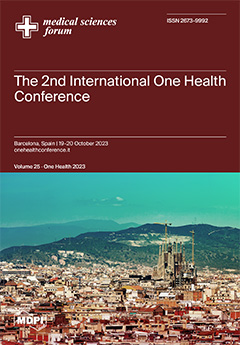Open AccessConference Report
Preface and Abstracts of the 2nd International One Health Conference
by
Margherita Ferrante, Gea Oliveri Conti, Domenico Vito, Gabriela Fernandez, Carol Maione, Paolo Lauriola, Prisco Piscitelli, Melissa Jimenez Gomes Tagle, Carlos Dora, Jordi Serrano Pons, Carole Conforti, Joima Panisello, Paula Sol Ventura, Ilaria Bernotti, Carmen Ruiz Martin, Edgar Buloz, Marcella Trombetta, Giuseppe Banfi and Valentina Tageo
Viewed by 2081
Abstract
The International One Health Conference 2023, scheduled for October in Barcelona, fosters a collaborative, multidisciplinary approach to health involving professionals, academics, and decision-makers. Operating in a hybrid format, the conference aims to bridge the gap between scientific knowledge and policies, aligning with the
[...] Read more.
The International One Health Conference 2023, scheduled for October in Barcelona, fosters a collaborative, multidisciplinary approach to health involving professionals, academics, and decision-makers. Operating in a hybrid format, the conference aims to bridge the gap between scientific knowledge and policies, aligning with the Sustainable Development Goals (SDGs) and Health in All Policies (HiAP). Emphasizing community involvement and the symbiotic relationship between basic needs, sustainable lifestyles, and empowerment, the conference envisions a comprehensive approach to sustainable development. D’Alisa introduces a framework incorporating participative democracy, recognizing the interconnectedness of economic, social, environmental, and participative democratic dimensions. Framing questions for the conference delve into critical aspects, addressing the integration of the One Health framework within health sectors, emphasizing interlinkages between health, climate change, and decision-making. The conference’s five-dimension framework tackles the complexity of One Health, addressing concerns, solutions, and opportunities in a holistic paradigm.
Full article
►▼
Show Figures



